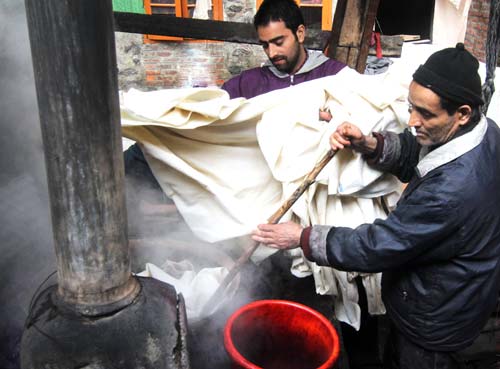Colours of shawls, pashmina and other Kashmiri art fabrics are known to fill senses with delight. But behind such pleasant colours, there is a Rangreez, Bilal Handoo profiles the community of dyers in Srinagar city.
Every morning, multi-colour shawls spread out on the ropes tied to electric poles add to the vibrant atmosphere at Rangarstop area of old Srinagar city where the Rangreez (Dyer) community of Kashmir who have been dyeing fabrics for many decades now, live.
Over the passage of time, the community has been reduced to six families who live in traditional Kashmiri houses which reflect scenes of cultural abodes of yesteryears in old city. Almost all types of shawls are brought here for dyeing that include Pashmina shawls, Raffal shawls, Count shawls, Toosha shawls, Silk sarees, Poly-wool, cotton, or Khadi products.
Khurshid Rangrez, 28, looks absorbed as he spreads out a shawl on a rope to let it dry in open sun. He has been dyeing fabrics for many years now. “My father was the sole member in my family who was in this trade. But as an elder son in the family, I decided to carry forward this practice,” Khurshid, a science graduate, says.
A well-built youth with brown eyes, Khurshid was relentlessly chasing government jobs three years ago to secure his future. “I realized that I was wasting my talent by searching a government job, simply because there is not even the remotest possibility of getting a job in a state afflicted by corruption,” he claims.
“Now I want to take this trade to the next level.”
As he speaks, many dyers around him are busy in dyeing shawls in large copper vessels in the backyard of Rangreez community. These are 16 such dyeing pools that remain operational throughout the year.
Early in the morning, the dyers fill these vessels with clean water. Firewood is then ignited in the hearth at their base. As the water boils, dye is added to it as per the colour requirement of the fabrics. “Earlier we used to mix plant dyes. But now we make use of chemical dyes,” Mohammad Ashraf, 52, father of Khurshid, says.
“At once, 60 to 100 shawls are dyed in a single pool at 100 to 180 degrees temperature. Many shawls of different colours are dyed in the same water. This is an inherent skill that provides us an insight of colour combination,” Ashraf says, “After dyeing fabrics with black colour, the same water can be used for dyeing blue or any other colour fabrics. It requires the knowledge of colour combination.”
From an economic point of view, dyeing is a lucrative trade. Six families earn Rs 1.5 lakh daily. A single piece of shawl is dyed for Rs 50 and 3000 shawls are dyed per day. The trade roughly fetches Rs 5.4 crore to the families every year. “But the rising cost of raw materials and other expenditures hardly leaves anything to cheer about,” Altaf Rangrez, 42, one of oldest dyers, says.
The congested workplace presents a nostalgic look with designed, wooden items visible everywhere. Many families have raised new structures in the vicinity of the yard, perhaps soon after dividing business. Besides, some Rangreez families have moved to other places of the city to explore better options in life. But the oldest families associated with dyeing still live here.
Among the 20 odd workers, some have been working for close to 50 years now. Abdul Rahim of north Kashmir’s Bandipora district and Bashir Ahmad of south Kashmir’s Islamabad district are two such workers. “I have worked with three generations of dyers here,” Bashir Ahmad says, “Earlier, everybody was working together when Ghulam Mohidin Bhat was around.”
It is said that Bhat pioneered the ‘dyeing art’ of fabrics in the area. Later on, the family came to be known as Rangreez instead of Bhats. In fact, the locality also came to be known as Rangerstop after them. But many say dyers came to Kashmir from Central Asia.
Other than Rangarstop, few households in old city are in dyeing business but they are not much in number. Of late, many have winded up this practice owing to the shortage of manpower and other reasons. But it appears the trade isn’t dying, not very soon.
















